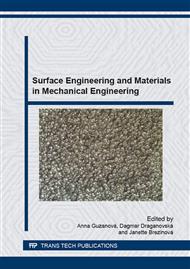p.53
p.57
p.61
p.65
p.69
p.74
p.78
p.83
p.89
Tribological Properties of Coatings for Sheet Metal Stamping Dies
Abstract:
The conventional and innovative surface technologies are applied to sheet metal stamping dies in order to produce a composite material with properties unattainable in either the base or surface material. To select proper materials for forming dies the systematic evaluation of dies materials, their heat treatment and coatings are required. This paper deals with evaluation of plasma sprayed coatings Cr2O3, Al2O3 and WC12Co by pressure plate-ring test (tester T 05) and deep drawing process. Friction coefficients and seizure of these coatings were studied under dry and wet friction conditions. For different types of die rings (with and without ceramic coatings) the punching forces were measured during deep-drawing process. The results show that the main advantage of application of plasma sprayed coatings on the die contact surfaces under wet friction conditions compare to dies made of the tool steel may be the increase of seizure resistance of stamped part surface. The more significant difference in the friction coefficient values was not observed.
Info:
Periodical:
Pages:
69-73
Citation:
Online since:
May 2015
Authors:
Price:
Сopyright:
© 2015 Trans Tech Publications Ltd. All Rights Reserved
Share:
Citation:


